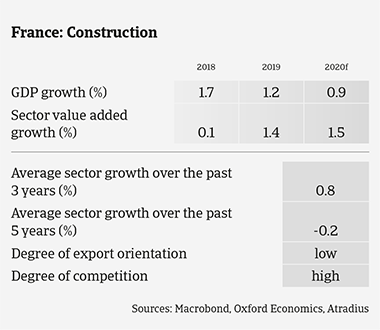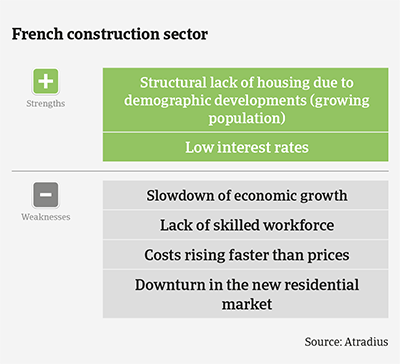Growth of French GDP is expected to slow down further in 2020, and the outlook for the construction sector is rather subdued across all major segments.

Market Monitor Construction France 2020 overview
The French Builders Association FFB (Fédération Française du Bâtiment) estimates construction output growth at 1.2% in 2019 (after growing 2.3% in 2018 and 5% in 2017). The modest increase was sustained by non-residential works, while residential construction performed poorly (up 0.8% only).
In 2020 residential construction output is forecast to contract 1%. New housing permits are expected to decrease by about 1.5%, affecting both single-family and multi-family housing. The decline is mainly due to lower public spending. Since 2018, the scope of beneficiaries for tax exemptions (both first-time buyers and investors) has been significantly reduced, and investment in social housing has declined. Businesses active in residential construction often suffer from tight margins and working capital requirement issues.
Commercial and public construction losing steam
Non-housing construction output increased 5.1% in 2019, driven by robust demand for industrial and logistics buildings, and, on a smaller scale, office buildings (mainly in the Paris area). However, production growth is expected to slow down to 2.8% in 2020 due to decreasing demand from the retail sector, while industrial investments are hampered by modest economic growth.
The public construction segment is losing steam after two dynamic years helped by the electoral cycle. Order books are decreasing since September 2019, and output is expected to slow down in H2 of 2020. The Grand Paris project will continue to sustain the segment in the coming years. However, businesses active in this subsector already suffer from fierce competition and slim margins. The cancellation of tax breaks in 2020 will have a negative effect on companies´ financials.
Construction materials value added is expected to contract 0.3% in 2020 after decreasing 0.4% in 2019. The market remains sluggish with tight margins for businesses.
While construction businesses face higher prices for commodities and energy as well as increased labour costs, they struggle to pass on those price increases due to fierce competition. Larger contractors keep putting pressure on their subcontractors. Operating margins remained tight in 2019, whereas a significant amount of cash was needed to fund order books. Cash management remains a major issue for many (mainly smaller) construction businesses, while banks are rather unwilling to provide loans to the industry. The cancellation of tax breaks (for non-road diesel fuel and social charges of construction workers) will contribute to a decrease in profit margins in 2020.

Market Monitor Construction France 2020 sector growth
Payment delays have significantly increased
Payments in the construction industry take about 65 days on average. The payment experience over the past two years has been rather bad, and non-payment notifications have significantly increased since H2 of 2018, reflecting difficulties in the structural works and single-housing construction segments.
According to the Banque de France, construction insolvencies decreased 6.2% year-on-year in January-November 2019. Among those that failed, companies with more than ten employees were mainly affected. Bucking the overall trend, the single-family homes segment showed a high deterioration (up 19%). While business failures decreased, payment delays increased at the same time. This reflects a situation where many construction businesses encountered only temporary cash problems in financing increased working capital requirements. In 2020 construction insolvencies are expected to level off or to increase slightly by about 2%.
Due to the subdued performance outlook our underwriting stance remains restrictive across all subsectors. However, we continue to provide cover to our customers whenever it is reasonable and prudent to do so.
We focus on the cash situation and loan facilities available to buyers, especially smaller and mid-sized companies. Several key financial indicators must be analysed: the level of activity, margins and ability to fund working capital requirements. High financial costs are a key indicator of potential pressure on cash. We also try to assess the ability of construction businesses to manage bigger projects than usual, as we often notice that smaller enterprises cannot cope with financial distress due to insufficient pricing and allocation of resources.

Market Monitor Construction France 2020 strengths & weaknesses

Market Monitor Construction France 2020 performance forecast
Documentos relacionados

1.42MB PDF
